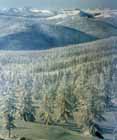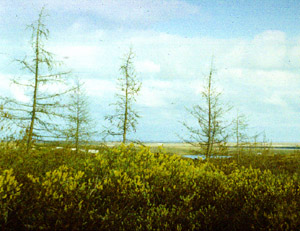Larix gmelinii
(Ruprecht) Kuzeneva 1920
Common names
Dahurian larch; Лиственница Гмелина [Russian]; 落叶松 luo ye song [Chinese]; グイマツ Gui-natsu [Japanese]; 잎갈나무 [Korean].
Taxonomic notes
Synonymy (Farjon 1990):
- Abies gmelini Rupr.;
- Larix dahurica Turcz. ex Trautvetter 1846;
- L. kamtschatica (Endl.) Carrière;
- L. sibirica Maxim. non Ledeb.;
- L. amurensis hort. in Beissn., pro syn.;
- L. cajanderi Mayr;
- L. dahurica var. pubescens Patschke;
- L. dahurica var. prostata Regel;
- L. dahurica f. macrocarpa Liou & Wang;
- L. dahurica f. glauca Liou & Wang;
- L. dahurica f. denticulata Liou & Wang;
- L. komarovii Kolesn.;
- L. ledebourii (Rupr.) R. Tsinovskis;
- L. middendorfii Kolesn.;
- L. ochotensis Kolesn.;
- L. gmelinii var. hsinganica Yang & Chou;
- L. heilingensis Yang & Chou.
Where the two species are distinguished (as they often are in Russia), L. gmelinii s.s. occurs from central Siberia E to about longitude 120°E to 125°E, which area comprises a zone of hybridization with L. cajanderi, which occurs in nearly all of forested Siberia E of longitude 125°E (Farjon 1990).
"Larix gmelinii and L. cajanderi do not differ in either qualitative morphological features or quantitative measurements. There is both geographical and ecological isolation between them. Larix cajanderi grows in more rigorous ecological conditions than L. gmelinii... [D]ifferences in the qualitative characteristics are gradual and are probably caused by clinal variation" (Milyutin and Vishnevetskaia 1995).
Most of the synonyms listed above reflect variation encountered between E Asian populations. For example, "Larix heilingensis Yang & Chou has been described from the low mountains east of Harbin (Heilongjiang) in NE China (Yang, Chou, and Nie, 1964). Its strongly pubescent seed scales seem to be the most striking feature, but this pubescence is also present in some (young) cones from other parts of the range and is a very variable character. Cheng and Fu (1978) treated it as a synonym of L. olgensis Henry, but its cones (judging from Chinese drawings and descriptions, specimens not seen) are much smaller and very much unlike Henry's type. Other very minor differences with L. gmelinii and L. olgensis, as tabulated by Yang, Chou, and Nie (1964) are all within the variations found in the typical variety of L. gmelinii, so it seems appropriate to treat L. heilingensis Yang & Chou as a synonym of L. gmelinii (Rupr.) Rupr." (Farjon 1990).
Along its western margin, the range of L. gmelinii is contiguous with that of L. sibirica, with which it readily hybridizes to form the nothospecies Larix ×czekanowskii Szafer 1913. See the "Remarks" section below for a fuller discussion.
Farjon (1990) distinguishes three varieties (besides the type) of L. gmelinii, all occurring in E Asia:
(1) Larix gmelinii var. japonica (Regel) Pilger
(2) Larix gmelinii var. olgensis (Henry) Ostenf. & Syrach Larsen
(3) Larix gmelinii var. principis-rupprechtii (Mayr) Pilger
Description
Trees to 35 m tall and 150 cm dbh, often much smaller due to harsh sites and climates; long, horizontally spreading branches and on open crown. Bark on young trees smooth, red-brown, becoming darker and grayer with age, scaly, and longitudinally fissured. First-year branchlets ca. 1 mm diameter, yellow-brown aging to gray-brown, the surface ridged and grooved, smooth and shining; pubescence variable, usually weak, or glabrous; pulvini weakly developed on long shoots; short shoots 2-6 mm diameter, cylindrical, yellowish hairy at apex. Vegetative buds ovoid-globose, with acute apex, lateral buds of short shoots globose, 2-3 mm, not or slightly resinous; bud scales ovate or obtuse-triangular, the inner scales with ciliate margins, dark brown, deciduous. Leaves bright green, yellow in autumn; on long shoots spirally arranged, spreading radially or directed forward; on short shoots spirally arranged, crowded, 20-30 per bud, 15-30 × 0.5-1 mm, truncate at base, widest near apex, soft and flexible, cross-section diamond-shaped, or flattened and keeled below, apex variable; stomata in two narrow bands separated by a keel below, none or a few above; resin canals 2, extremely lateral, marginal, small. Pollen cones terminal on short shoots, 5-7 mm long, yellow. Seed cones terminal on short shoots, turned erect, with a short, curved peduncle; purple-red, ripening brown, ovoid-oblong, 0.8-4 × 0.8-3 cm; old cones persistent, falling with twigs. Seed scales 14-45, pentagonal-ovate, 0.5-1.5 × 0.4-1.2 cm at middle of cone, glabrous and glossy abaxially, upper margin entire, rounded or truncate, sometimes weakly emarginate and slightly recurved; base narrowed or slightly pedicellate. Bract scales broad ligulate-lanceolate, apex trilobate with longer cusp, length 1/3-1/2 × seed scales, included except at the base of the cone, but visible with opened seed scales. Seeds gray with light brown spots, obliquely ovoid, 2-3 × 1-2 mm, ca. 10 mm including the bright orange-brown wing. Pollination May to June, seed maturity September (Fu et al. 1999, Farjon 1990).
Var. gmelinii differs from the other varieties in having "First-year long branchlets slender, ca. 1 mm in diam. Short branchlets 2-3 mm in diam. Seed cones 1.2-3 × 1-2 cm. Seed scales 14-30, dehiscent at maturity" (Fu et al. 1999).
Distribution and Ecology
Russia: the typical variety occurs in E Siberia, Sakhalin, the inner valley of Kamchatka, NE Mongolia; NE China: Heilongjiang, Jilin, Nei Mongol; and Korea (Farjon 1990, Vladimir Dinets e-mail 1998.01.02, Fu et al. 1999). The other varieties are generally found in SE Russia, the Kuril Islands, and China: Hebei, Henan, Jilin, Shanxi (Farjon 1990, Fu et al. 1999). Hardy to Zone 1 (cold hardiness limit below -45.6°C) (Bannister and Neuner 2001, variety not specified), which makes it one of the most cold-hardy trees known.
When taken together with its varieties, this is one of the most widespread conifers on earth, and is likely the most numerous in terms of the numbers of mature trees. "Larix gmelinii var. gmelinii occupies a very large area and therefore occurs in a wide range of habitats: on lowland subarctic plains, in river valleys, on low mountains and also on the edges of moors and swamps. Its elevational range is between 300-1200 m. The soils are affected by permafrost over much of the range; the climate is continental-subarctic, with very cold winters, and relatively dry (400-500 mm in the Greater Hinggan Range) to extremely dry in the subarctic interior. It is the only tree species in E Siberia reaching the tree limit at 70° N, but in the more southern part of its range it is commonly mixed with Abies sibirica, Picea obovata and Pinus sylvestris. In the boreal coniferous forest it is a climax species only on permafrost or peaty soils" (Farjon 1990).
L. gmelinii has low resistance to fire but propagates prolifically in the aftermath of fire; this dynamic is one reason why it is the dominant, often the only tree species over vast areas (Tsvetkov 2004).
In 2011, the IUCN assessed conservation status of L. gmelinii, its type variety, var. japonica, and var. principis-rupprechtii as "least concern", with an assessment of "near threatened" for var. olgensis (Farjon 2013, accessed 2022.03.20).
Remarkable Specimens
The tallest may be on Pyaktusan Mountain on the China-Korea border: 46 m tall (Vladimir Dinets e-mail 1998.01.02).
The oldest known specimen, 631 years, was documented in a tree-ring chronology covering the period 513-1997 (fully crossdated), collected on the Taymir Peninsula, northern Russia by Rosanne D'Arrigo, Rob Wilson, and Gordon Jacoby (doi.org/10.25921/zknj-6494). The record for this tree ended in 1861. The oldest recorded living tree was 600 years, documented in a tree-ring chronology covering the period 1398-1997 (crossdated after 1438), collected in northern Russia by Gordon Jacoby and colleagues (doi.org/10.25921/vfgn-3k17, chronology russ218.rwl).
Ethnobotany
"The timber is used for construction, poles, vehicles, bridge building, and wood fiber. The trunk is used for producing resin, and the bark for tannins. The species is also cultivated for afforestation and as an ornamental" (Fu et al. 1999).
The species has been involved in several dendrochronological studies. Work to date includes an exploratory study (Osawa 1993) and three chronologies with climate reconstruction (Earle et al. 1994, Shiyatov et al. 1996, Macdonald et al. 1998).
Observations
Remarks
The nothospecies Larix ×czekanowskii Szafer 1913 (type: Russia, Tunguska River below mouth of Tomezoy River, A. Czekanovsky & F. Muller s.n.) is a product of natural hybridization between L. gmelinii and L. sibirica where their distributions are contiguous in a wide belt extending N to NW from Lake Baikal to the mouth of the Yenisei River. The species was named for a Polish geologist who studied the Lake Baikal basin in the 1860's and early 1860's, and who was its first collector. The trees are intermediate in character states between the two parent species, and this is particularly evident in their cones, which resemble those of L. gmelinii var. principis-rupprechtii. The species occurs on highly varied soils under a dry continental climate with extremely long and cold winters. It is a component of taiga forest with Picea obovata, Pinus sylvestris, Betula pendula, and Populus sp. Its wood is used in construction (e.g. traditional log houses), railroad ties, veneers, and as a source of pulp for paper (Farjon 2010).
Citations
Earle, Christopher J., Linda B. Brubaker, Andrei V. Lozhkin and Patricia M. Anderson. 1994. Summer temperature since 1600 for the upper Kolyma region, northeastern Russia, reconstructed from tree rings. Arctic and Alpine Research 28(1).
Farjon, Aljos. 1990. Pinaceae: drawings and descriptions of the genera Abies, Cedrus, Pseudolarix, Keteleeria, Nothotsuga, Tsuga, Cathaya, Pseudotsuga, Larix and Picea. Königstein: Koeltz Scientific Books.
Kuzeneva. 1920. Trudy Bot. Muz. Rossiisk. Akad. Nauk 18: 41.
MacDonald, G.M., R.A. Case and J.M. Szeicz. 1998. A 538-year record of climate and treeline dynamics from the lower Lena River region of northern Siberia, Russia. Arctic and Alpine Research 30: 334-339.
Shiyatov, S.G., V.S. Mazepa, E.A. Vaganov and F.H. Schweingruber. 1996. Summer temperature variations reconstructed by tre-ring data at the polar timberline in Siberia. P.61-70 in Dean et al., Tree Rings, Environment and Humanity. Radiocarbon 1996. Tucson: University of Arizona Department of Geosciences.
Szafer, W. 1913. Larix x czekanowskii hybr. nov. Kosmos 38:1281-1322 (p. 1297).
Tsvetkov, P. A. 2004. Pyrophytic properties of the larch Larix gmelinii in terms of life strategies. Russian Journal of Ecology 34(4): 1067-4136. Abstract: The pyrophytic properties of the larch Larix gmelinii (Rupr.) Rupr. growing in the northern taiga of central Siberia have been studied. It has been found that, although the trees are highly combustible and fire resistance of tree stands is low, the species is highly pyrophytic, which allows it to retain its geographic range. At early stages of postfire successions, the larch exhibits characteristics of pyrogenic explerent and is subject to r-selection. When forest restoration is close to completion, the species passes into the patient state and acquires properties subject to K-selection.
See also
Elwes and Henry 1906-1913 at the Biodiversity Heritage Library (as L. dahurica) (Photo). This series of volumes, privately printed, provides some of the most engaging descriptions of conifers ever published. Although they only treat species cultivated in the U.K. and Ireland, and the taxonomy is a bit dated, still these accounts are thorough, treating such topics as species description, range, varieties, exceptionally old or tall specimens, remarkable trees, and cultivation. Despite being over a century old, they are generally accurate, and are illustrated with some remarkable photographs and lithographs.
Sakai, A. and M. Saito. 1974. Dahurian larch trees in Yakutia. Journal of the Japanese Forestry Society. 56:247-252 [In Japanese, with English abstract].
Uemura, Shigeru, Satoshi Tsuda and Sakae Hasegawa. 1990. Effects of fire on the vegetation of Siberian taiga predominated by Larix dahurica. Canadian Journal of Forest Research 20:547-553.





